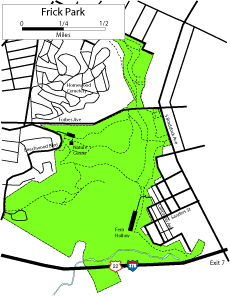
Frick Park
| Allegheny |
| DESCRIPTION: This 500-acre tract of mature deciduous woodland in the East End section of Pittsburgh, is a major stop-over for migrating land birds. The stream in Fern Hollow (Nine Mile Run) has gone through a major restoration in recent years. The floodplain of the stream has been restored and wetlands and ponds have been created. It has been too recent to list the species that these wetlands will attract, but the potential is great. March features the return of the Eastern Phoebes, Brown Creepers, Winter Wrens, Golden-crowned Kinglets, Hermit Thrushes and Fox Sparrows. A brushy meadow near where the nature center used to be is an excellent site to find these birds. Warblers are the real reason to visit Frick Park in spring, with huge numbers pouring through the park during the first three weeks of May. The first Louisiana Waterthrush arrive in early April. They prefer the Falls Ravine and Fern Hollow sections of the Park. Pine, Yellow-rumped and Black-and-white warblers are next, with first dates around mid-month. By the last week of April, Nashville, Yellow and Black-throated Green warblers are showing strong passages, and just about anything else is possible. Early and mid-May see hordes of Tennessee, Chestnut-sided, Magnolia, Blackburnian, and Bay-breasted warblers. Yellow-throated and Worm-eating Warblers are rare but regular. Blackpoll, Mourning, Wilson's and Canada warblers are most common in late May. Flycatchers, thrushes and vireos are also common May transients, with records for all species regular to Pennsylvania. Breeding species include Red-bellied Woodpecker, Acadian Flycatcher, Carolina Chickadee, Blue-gray Gnatcatcher, White-eyed, Red-eyed, and Warbling vireos, American Redstart, and Hooded Warbler. August birding is often good but unpredictable— some days are very slow. Others, often associated with cold fronts, are excellent. Chestnut-sided and Blackburnian warblers are very common, and Empidonax flycatchers are numerous in the second half of the month. Large numbers of Common Nighthawk, Chimney Swift, swallows, American Robins, and blackbirds patrol the park's skies. Fall migration peaks in early September and slowly peters out over the next three months. By mid-December most birds still in the park can properly be regarded as winterers. Great Horned Owl and Eastern Screech-Owl, both nesters, are often heard on winter nights. Black-capped Chickadee are fairly common winter visitants. Dark-eyed Junco and White-throated Sparrow are common, and small flocks of winter finches are sometimes noted. Cedar Waxwing wander widely in big flocks that gradually dwindle as berry supplies are exhausted with the progression of winter. |
DIRECTIONS: Frick Park can be accessed from many points along Beechwood Boulevard, Forbes Avenue, or Braddock Avenue. The park headquarters, where maps are sometimes available, is located along Beechwood Boulevard, less than 0.5 mile from the intersection of Forbes Avenue and Beechwood Boulevard. Braddock Avenue is reachable from Exit 7 on I-376. |
|
Maps - other than Google (Click on map for larger view) |
|
Sub-sites |
Photos |
| Posted: 2009-10-24 00:00:00 Updated: |
